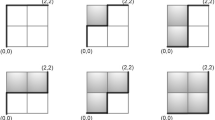Abstract
Sakata’s generalization of the Berlekamp–Massey algorithm applies to a broad class of codes defined by an evaluation map on an order domain. In order to decode up to the minimum distance bound, Sakata’s algorithm must be combined with the majority voting algorithm of Feng, Rao and Duursma. This combined algorithm can often decode far more than (d min −1)/2 errors, provided the errors are in general position. We give a precise characterization of the error correction capability of the combined algorithm. We also extend the concept behind Feng and Rao’s improved codes to decoding of errors in general position. The analysis leads to a new characterization of Arf numerical semigroups.
Similar content being viewed by others
References
Arf C. (1948). Une interprétation algébrique de la suite des ordres de multiplicité d’une branche algébrique. Proc Lond Math Soc 50(2):256–287
Atiyah M.F., Macdonald I.G. (1969). Introduction to commutative algebra. Addison-Wesley, Reading, MA
Barucci V., Dobbs D.E., Fontana M. (1997). Maximality properties in numerical semigroups and applications to one-dimensional analytically irreducible local domains. Mem Am Math Soc 125(598):x+78
Bourbaki N. (1972). Commutative algebra. Addison-Wesley, Reading, MA
Bras-Amorós M. (2003). Improving evaluation codes. PhD Thesis, Universitat Politècnica de Catalunya, Barcelona
Bras-Amorós M. (2004). Acute semigroups, the order bound on the minimum distance, and the Feng–Rao improvements. IEEE Trans Inform Theory 50(6):1282–1289
Campillo A., Farrán J.I., Munuera C. (2000). On the parameters of algebraic–geometry codes related to Arf semigroups. IEEE Trans Inform Theory 46(7):2634–2638
Duursma I.M. (1993). Majority coset decoding. IEEE Trans Inform Theory 39(3):1067–1070
Feng G.L., Rao T.R.N. (1993). Decoding algebraic-geometric codes up to the designed minimum distance. IEEE Trans Inform Theory 39(1):37–45
Feng G.-L., Rao T.R.N. (1995). Improved geometric Goppa codes. I. Basic theory. IEEE Trans Inform Theory 41(6, part 1):1678–1693 (Special issue on algebraic geometry codes)
Garcia A., Stichtenoth H. (1996). On the asymptotic behaviour of some towers of function fields over finite fields. J Number Theory 61(2):248–273
Geil O., Høholdt T. (2000). Footprints or generalized Bezout’s theorem. IEEE Trans Inform Theory 46(2):635–641
Høholdt T., van Lint J.H., Pellikaan R. (1998). Algebraic geometry codes. North-Holland, Amsterdam, pp 871–961
Jensen H.E., Nielsen R.R., Høholdt T. (1999). Performance analysis of a decoding algorithm for algebraic-geometry codes. IEEE Trans Inform Theory 45(5):1712–1717
Lipman J. (1971). Stable ideals and Arf rings. Am J Math 93:649–685
O’Sullivan M.E. (1995). Decoding of codes defined by a single point on a curve. IEEE Trans Inform Theory 41(6, part 1):1709–1719 (Special issue on algebraic geometry codes)
O’Sullivan, M.E.: Decoding of Hermitian codes beyond (d min −1)/2. In: Proceedings of the 1997 IEEE international symposium on information theory, pp 384. Germany: Ulm 1997
O’Sullivan M.E. (2001). New codes for the Berlekamp–Massey–Sakata algorithm. Finite Fields Appl 7(2):293–317
Pellikaan R. (1992). On decoding by error location and dependent sets of error positions. Discrete Math 106/107:369–381 (A collection of contributions in honour of Jack van Lint)
Pellikaan R., Stichtenoth H., Torres F. (1998). Weierstrass semigroups in an asymptotically good tower of function fields. Finite Fields Appl 4(4):381–392
Rosales J.C., García-Sánchez P.A., García-García J.I., Branco M.B. (2004). Arf numerical semigroups. J Algebra 276(1):3–12
Sakata S. (1990). Extension of the Berlekamp–Massey algorithm to N dimensions. Inform Comput 84(2):207–239
Stichtenoth H. (1988). A note on Hermitian codes over GF(q 2). IEEE Trans Inform Theory 34(5, part 2):1345–1348 (Coding techniques and coding theory)
Author information
Authors and Affiliations
Corresponding author
Rights and permissions
About this article
Cite this article
Bras-Amorós, M., O’Sullivan, M.E. The Correction Capability of the Berlekamp–Massey–Sakata Algorithm with Majority Voting. AAECC 17, 315–335 (2006). https://doi.org/10.1007/s00200-006-0015-8
Received:
Published:
Issue Date:
DOI: https://doi.org/10.1007/s00200-006-0015-8




